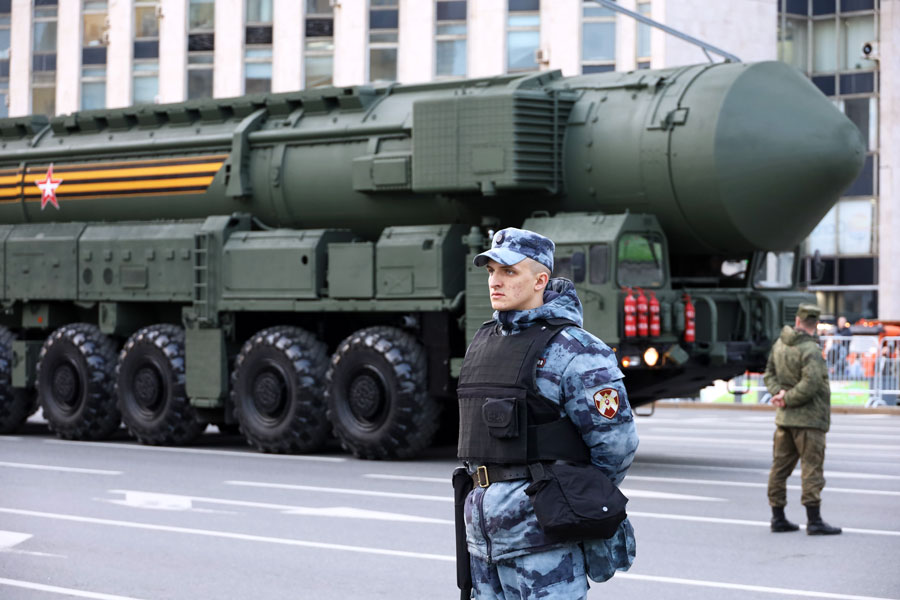
WASHINGTON, D.C. – Tensions between Russia and the West escalated sharply this week after the United States announced plans to send long-range missile systems to Ukraine, prompting a series of nuclear warnings from senior Russian figures and state-aligned media outlets.
The response followed reports that President Donald Trump, in coordination with NATO allies, intends to deliver Patriot air-defense systems and potentially cruise missiles, such as Tomahawks, to bolster Ukraine’s defense. These weapons, capable of reaching deep into Russian territory, have been at the center of concern among Kremlin officials and military commentators who argue such deployments could cross a red line in the ongoing conflict.
Russian media figures closely aligned with the Kremlin have characterized the U.S. weapons plan as a direct provocation, suggesting it could warrant a nuclear response. State broadcasters aired programs featuring warnings of “Hiroshima-style consequences” should Ukrainian forces be empowered to strike Russian cities. Analysts view these remarks as part of a coordinated campaign to frame any escalation by Western powers as justification for the use of Russia’s strategic arsenal under its recently revised nuclear doctrine.
Under the new guidelines, adopted in late 2024, Russia formally expanded the conditions under which it could launch a nuclear strike. The policy now includes responses not only to nuclear threats but also to conventional attacks if they are supported or enabled by allied third parties, such as NATO-member countries. This shift has raised concerns among global security experts about the threshold for nuclear deployment in a high-stakes, proxy-based battlefield like Ukraine.
While no official orders have been issued from the Kremlin, public statements from prominent government supporters, coupled with the amplification of nuclear messaging across Russia’s state media, have fueled speculation about Moscow’s strategic intentions. At the same time, Western intelligence and defense agencies have observed increased activity at multiple Russian nuclear facilities, including upgrades and logistical preparations at bases near NATO’s eastern flank.
Trump’s recent remarks added to the uncertainty. According to multiple reports, the former president suggested that Ukraine may be granted a 50-day window to reach a ceasefire with Moscow, and that further military aid could be contingent on progress toward peace. In private discussions, he is also said to have asked whether Ukraine would consider targeting Russian cities with the long-range weapons being discussed. While the White House has clarified that no encouragement was given to strike Russian civilian targets, the conversation itself has raised alarm in diplomatic circles.
The Kremlin, for its part, has dismissed much of the rhetoric as posturing, with official spokespeople accusing the U.S. of escalating the war for political purposes. Still, behind the scenes, Russia appears to be signaling that it is preparing for all contingencies, including the possibility of a more direct confrontation with Western forces.
The growing friction comes amid continued battlefield stalemates in eastern Ukraine, where Russian and Ukrainian forces remain locked in attritional combat with limited movement along the front lines. As Western military aid continues to flow into Ukraine, Moscow has intensified its warnings, positioning its nuclear arsenal as a deterrent and a potential tool of last resort.
International observers are now closely watching for any changes in troop movements, weapons deployments, or diplomatic overtures in the days ahead. The prospect of miscalculation – particularly with long-range weapons in play – has added a new level of urgency to efforts aimed at de-escalating the conflict before it crosses a dangerous threshold.
Q&A: U.S.-Russia Tensions Over Long-Range Missiles and Nuclear Threats
Q: What prompted Russia’s recent nuclear warnings?
A: Russia’s response was triggered by the U.S. pledge to send long-range missile systems—such as Patriot air-defense and potentially Tomahawk cruise missiles—to Ukraine. Russian officials and state media claim these weapons could be used to strike targets deep inside Russian territory.
Q: Has Russia officially threatened to use nuclear weapons?
A: No formal order or declaration has been issued. However, several high-profile Russian media figures and government allies have publicly warned of nuclear retaliation if long-range weapons are used against Russia. These remarks are viewed as strategic messaging consistent with past Kremlin tactics.
Q: What is different about Russia’s nuclear doctrine now?
A: In late 2024, Russia revised its nuclear policy to allow for a nuclear response not only to nuclear threats, but also to conventional attacks if they involve third-party military support—such as NATO-supplied weapons systems. This lowers the threshold for potential nuclear use in proxy conflicts.
Q: Did Trump actually approve sending Tomahawks to Ukraine?
A: It has not been confirmed that Tomahawk cruise missiles are being sent. However, discussions reportedly took place about their potential inclusion in U.S. military aid packages. The confirmed support so far includes Patriot systems and other long-range capabilities.
Q: What did Trump reportedly ask about Ukrainian strikes?
A: According to reports, Trump asked Ukrainian President Volodymyr Zelensky whether Kyiv would consider striking Russian cities like Moscow or St. Petersburg if given long-range missiles. There’s no evidence that Trump advocated for such attacks, and later statements indicated that he did not encourage it.
Q: Are there signs Russia is preparing for escalation?
A: Satellite imagery and intelligence assessments suggest Russia is upgrading several nuclear-related facilities, including those near NATO’s borders. These moves, combined with the rhetoric from Russian state figures, have raised concerns among Western analysts about potential escalation.
Q: What happens next?
A: The situation remains volatile. Both sides are watching each other’s military and diplomatic signals closely. While the U.S. and its allies continue supplying Ukraine, Russia appears to be using strategic threats—including nuclear rhetoric—as part of its deterrence posture.


